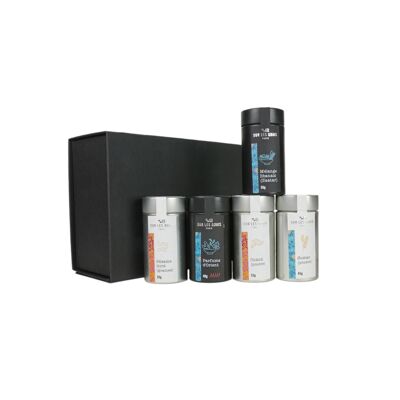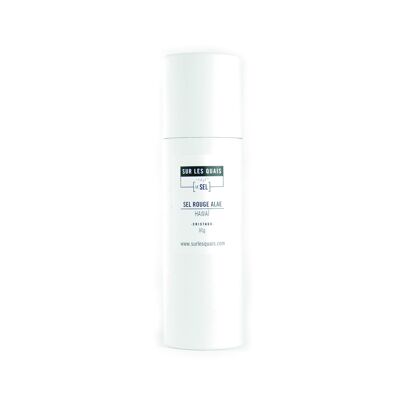


ESSENTIAL GIFT SET FOR CHRISTMAS AND THE HOLIDAYS SUR LES QUAIS has sourced this selection of Salts of the World from all corners of the planet. Depending on the geological characteristics of each region, these natural and precious salts take on magnificent colors or shapes. These salts are very useful for decorating your dishes: - Himalayan Pink Salt (25g): Himalayan salt is extracted from the mountains of the Salt Range, in the Punjab region of Pakistan, more precisely on the southern edge of the Pothohar Plateau. It is ideal for seasoning meats, grilled vegetables, salads, soups and blends well with dishes when baking. -Persian Blue Salt (25g): This salt is extracted by hand in the mountains of Iran, it gets its sublime blue reflections from sylvinite, a potassium compound. It offers an intense salinity that reveals spicy and tangy notes. It can be used crushed to highlight its dry and crunchy texture or can be used whole to add a touch of originality, surprise and aesthetics. -Cyprus Pyramid Salt (15g): Cyprus salt is known for its original and shiny pyramid shape. This unique shape is created by the process of solar evaporation of seawater. The water is channeled into a chain of ponds, then into large pots where it is gradually heated, forming the pyramidal shapes of the salt. This gourmet-quality flaked salt is ideal for cooking and baking. -Hawaiian Black Salt (25g): Hawaiian Black Salt is a blend of sea salt and black lava rock, rich in activated carbon (Hawaiian Black Salt occurs naturally when rains cascade down volcanoes and deposit volcanic rock residue into the sea). It is produced exclusively in the salt flats of Molokai and is found in many Hawaiian recipes. With its mineral aromas and iodized flavor, you can use it in all cuisines: seafood, meats, vegetables... but sparingly. It is mainly used as a finishing salt, which brings aesthetics, originality and flavor to your recipes. It is a very good alternative to fleur de sel. -Viking Salt (25g): Viking salt takes its name from the fearsome Scandinavian warriors who sowed terror in many lands in Europe, North America and even Russia between the 8th and 10th centuries. This mixture of salt and spices is characterized by smoky and iodized aromas and very strong flavors. It goes perfectly with eggs, meat or more particularly with seafood such as shellfish and salmon. -Murray River Salt (14g): This salt takes its name from the Murray River which runs through Australia. Its color and flaky appearance are due to a red algae that grows in the waters of this same river. You will therefore find in your mouth sweet flavors of seaweed, with non-iodized aromas because it is originally an earth salt. It is obtained in the Murray Darling salt basins after natural evaporation (a technique very similar to that of the production of fleur de sel from Guérande), which gives it its crispy texture and finesse. It can be used in all cuisines and goes wonderfully with fish, meat and vegetables. -Bolivian Mirror Salt (25g): This salt is extracted from the Salar de Uyuni, a prehistoric dried-up seawater lake, located at an altitude of 3000 meters in Bolivia. It is called "mirror" salt because the surface of the sea salt from which it comes reflects the light from the sky and thus gives the appearance of a giant mirror. With a slightly pink color, this one has a non-iodized flavor. This salt has been harvested by hand for two centuries and has a very pronounced salinity, which makes it ideal as table salt. -Hawaiian Red Salt (30g): This salt originates from the volcanic activity of the Hawaiian Islands, which are enriched with minerals. Its unique red color comes from the presence of Alaea, a sacred clay from the archipelago of the island of Molokai, where it is made. This salt has always been used to season and preserve food products. In cooking, it is used in all dishes, it goes well with meat, fish, shellfish, vegetables and salads. -Salish Salt of the Americas (30g): Salish salt is a sea salt from the Pacific Ocean in northern Washington State. It is called Salish, because the Native American populations, originally from this state, had the tradition of smoking salt with red alder wood, which gave it this incomparable color and smoky taste. In cooking, you can use it to enhance seafood (fish, shellfish) and with meat (grills).



























